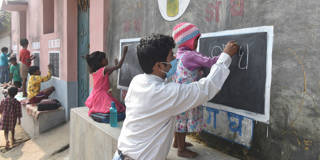A recent visit to rural West Bengal revealed what the right mix of inspiration, empathy, and commitment can achieve in the classroom. Providing poor children in remote areas with an innovative, quality education can make a big, cost-effective change for the better in the lives of the poorest among us.
KOLKATA – The world is battling a deadly virus that refuses to go away. War and brutality have returned to Europe, thanks to an unhinged tyrant in the Kremlin. And climate-related disasters – floods, fires, extreme storms, and droughts – are occurring with greater frequency and intensity than ever in developed and developing countries alike.
But the world is not completely without sources of inspiration and optimism. All it takes to appreciate this is a trip to Barandanga, a village adjacent to the small town of Para in the Purulia district of West Bengal. My aim during a recent four-day visit to the region was to study new initiatives to provide education, and particularly creative education, to the rural poor. But I gained much more. Largely cut off from the rest of the world with no newspapers or television, and visiting schools in one village after another, I felt a wonderful sense of hope.
This remote corner of West Bengal, bordering the state of Jharkhand, is largely tribal land. Tribes and clans such as the Santals, Shabars, and Murmus arrived here from Africa thousands of years before the so-called Aryan invasion, which began a little over 3,500 years ago. These tribal people are often illiterate and very poor.

KOLKATA – The world is battling a deadly virus that refuses to go away. War and brutality have returned to Europe, thanks to an unhinged tyrant in the Kremlin. And climate-related disasters – floods, fires, extreme storms, and droughts – are occurring with greater frequency and intensity than ever in developed and developing countries alike.
But the world is not completely without sources of inspiration and optimism. All it takes to appreciate this is a trip to Barandanga, a village adjacent to the small town of Para in the Purulia district of West Bengal. My aim during a recent four-day visit to the region was to study new initiatives to provide education, and particularly creative education, to the rural poor. But I gained much more. Largely cut off from the rest of the world with no newspapers or television, and visiting schools in one village after another, I felt a wonderful sense of hope.
This remote corner of West Bengal, bordering the state of Jharkhand, is largely tribal land. Tribes and clans such as the Santals, Shabars, and Murmus arrived here from Africa thousands of years before the so-called Aryan invasion, which began a little over 3,500 years ago. These tribal people are often illiterate and very poor.